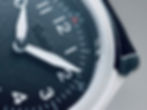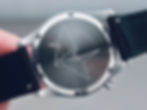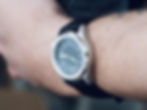Vario 1945 A-11S Raven Black
The Most Sensical A-11 Since WWII
September 10, 2025
by Vincent Deschamps
If I were to take a bet as to which genre of timekeeping device will be around 100 years from now, I would say it would be the field watch. Because the simpler something is, the more potential it has to be timeless, and so the more likely it is to be part of humankind for generations to come. And, I would add, because field watches were born from a practical need—to keep track of time for strategic purposes on the battlefield—and not from a design or fashion or vanity desire—to exist on the sole merit of its aesthetics, to accessorize our attire, or to signal our place in society—it will perdure even though technically we no longer need watches. Mechanical or otherwise. But we humans are beasts of emotions, and feelings and thoughts we pour over our wrist-worn machines, and so we are attached to these three-handers as much as we are to our cars, HVAC systems, and deep and inherent appreciation for what is purposeful.
Add to that Vario’s affinity for the vintage and for well-priced and thoughtfully designed and manufactured watches, and we are guaranteed a winning number each time the Singaporean brand releases a new model. I’ve reviewed many Vario’s in the past, only one so far for Mainspring (oopsy daizy,) being the 1918 Trench Grey in 37mm, though luckily Sophie was here to review the Empire Seasons True GMT Autumn Salmon. I’m a big fan of what the winning duo of Ivan and Judy are doing, have done, and will certainly continue to do in the future, and so it is with an immense pleasure that we’re about to put their latest creation under the microscope. The watch is the 1945 A-11S Raven Black, a solar-powered quartz field watch sized to perfection (35mm,) highly legible, robust, easy, and highly versatile. Though note that it also comes in a 40mm version and three colors in each size—Raven Black, Eagle Grey, and Heron White. It retails for a meager $198 USD.

Specifications
There won’t be any surprise as to what kind of machine ticks inside the 1945 A-11S and how it functions: a solar-powered quartz caliber, the Miyota 2070 (or 2170 for the 40mm version,*) with a stated accuracy of +/- 20 seconds per month and battery running time of four months after a full charge. (That is the watch will keep on ticking for 124 days in complete darkness.) This is the best-case scenario for a grab-and-go tool watch as virtually you won’t have to do any maintenance on the movement save for the unfortunate accident of dropping the watch into Mariana’s Trench on your next extreme-dive excursion. (I’ve dived with a field watch before. Don’t judge me.) The light is captured by way of a cell mounted on the rehaut and located at the 1 o’clock which is basically visually absent from our connoisseur’s gaze. This technology differs from the RZE Urbanist in that the solar cells were hidden inside the minute track which, honestly, meant charging the movement took longer.
*It’s pretty neat that Vario went as far as sourcing two versions of the movement to fit in two different sized cases.

The other advantage of having such a caliber is the fact that the watch is light, as in very light given also the fact that the case is small and highly nimble: indeed 35mm in diameter, 41mm lug-to-lug, 9mm thick, and coming with an 18mm lug width. (The larger version measures 40 x 48 x 9.5 x 20mm respectively.) I do have a thing for smaller watches and so the Vario 1945 A-11S wears superbly on my wrist as it would on any wrist. (You will soon find out why.) The combination of the small form-factor and featherweight profile of the caliber means this model can be worn with the highest degrees of comfort, and it also means it is highly versatile in the sense it is sized akin to a vintage dress watch—actually, very much so a World War II-era field watch—which to me translates to being capable of looking the part dressed up or dressed down, fetching kids from daycare or piloting a dual-engine plane over the Sahara Desert.

Moreover, and in spite of its modest dimensions—though one doesn’t relate to the other to be franc—, Vario didn’t skimp on equipping the 1945 A-11S with all the good stuff a modern tool watch should be equipped with. For example, the transparent thing atop the dial is a flat piece of sapphire crystal with several layers of inner anti-reflective coating, the lume is BGW9 SuperLuminova applied in good quantities on the hands and hour markers, the crown is small, grippy, and conveniently located at the 4 o’clock so that it doesn’t mush your skin like a meat-pounder. And along with a screw-down case-back, this little watch comes with a decent 50 meters of water resistance—which is enough, as I’ve mentioned many times before, for most folks most of the time. Moreover, the watch comes shipped on a Cordura re/cor™ strap made of recycled materials, a good intention which however translates to a stiff but robust fastening apparatus.

Design
If you are as fascinated by field watches as I am, and of course by military history, then you will be familiar with the stereotypical design such timekeeping devices come with: a handset, Arabic numerals for the hour markers, no date, and a contrasting dial/hand/markers combination. Nothing more, nothing less. The design inspiration for Vario’s latest gem is the A-11 commissioned by the U.S. Government in 1942 following the FSSC 88-W-800 specification which I touched upon in my review of the 34mm Benrus DTU-2A/P, to equip its infantry and paratroopers who would be joining the conflict. (I also wrote about this in my review of the Praesidus A-11 Type 44.) Just like the Praesidus, the Vario 1945 A-11S is actually part pilot, part field watch, on account of the leaf and sword hands respectively, the absence of a 24-hour military scale, and of the 10-minute increments printed outside the minute track.

But I choose to see the Vario as a field watch on account of its smaller, field watch period-correct form-factor and because the original A-11 was widely used on the ground by American paratroopers.

In addition to, or parallel to its vintage military inspiration, the Vario is resolutely modern because of the ways in which the dial is sized and laid out, and of the case shape. Even though it has the traditional Arabic numerals + legible hands combination, the numerals are printed small in a contemporary font, intimately hugging the simple minute track composed of small printed hash-marks for the minutes and slightly longer ones for the 5-minute increments. The hour and minute hands are relatively oversized compared to the markers which slap a modern and bold aesthetic to the 1945’s dial, something I’m a big fan of, an effect reinforced by the granular texture of the dial and the black-on-black embossed brand logo located above the pinion. On this version, the hour and minute hands are also endowed with white surrounds to make them pop from the dial to guarantee superlative legibility.
Now, Vario wanted to transform the traditional use-case scenario of field watches from being war-oriented pieces of equipment to becoming timekeeping devices which, according to the brand, could serve as symbols of military de-escalation. In other words, attempting to severe the historical connection field watches have had with armed conflicts by removing the Word War II-era hacking seconds feature of the original A-11 (for strategic purposes on the battlefield) and replacing it with a disc on which is printed a small white dot (so that we know the watch is running/) and by decorating the case-back with the image of an origami Crane which pays homage to Sadako Sasaki, an Hiroshima survivor who died in 1955 of acute malignant lymph gland leukemia caused by the radiations of the atomic bomb, and who more than allegedly folded one thousand Cranes before her passing with the hope of being granted a wish.

The Heart of the Matter
I didn’t think there would be so much to be said about such a small field watch, figuratively speaking. Looking at the Vario 1945 A-11S’ specifications, we are dealing with a practical, robust, and complete tool watch that can be used to do many things. From a design perspective, we’re also dealing with a practical timekeeping instrument which is highly legible, aesthetically versatile, and both inspired by 1940s military horological design and not. On the one hand, we find traditional design elements of field watches—the Arabic numerals, large hands, and contrasting dial—and on the other hand, we find elements which reroute this models’ intended purpose from being a tool of war to being a tool of peace, being equipped with a half polished/half-brushed case, an elegant one at that, a hidden hacking seconds hand, and a message of hope engraved on the case-back. So for those of you who would be acquiring a Vario 1945 A-11S, you would do so for one of two reasons, and in either case you would be wearing a sensical piece of horology.
But what this watch would mean to you is entirely up to you, of course.

Conclusion
So there are many ways to look at the Vario 1945 A-11S Raven Black. There is the pure horological one, looking at the specs and design of this piece. There is the philosophical and political one, looking at its identity transformation. And there is the value one, looking at how much watch one gets for the meager price of $198 USD. It is interesting to me to see the turn Vario is taking with this model, as the brand has re-issued many War-related timekeeping devices since its inception, from the Word War I Trench watches (complete with the shrapnel crystal protector) to the 1942 A-11 and the 1945 Dirty Dozen, and I wonder why it named this collection “1945” since the A-11 was issued before the end of the war. I guess this ties back to the message of peace, as the conflict ended in 1945. But maybe I’m going a little too far with this.
As always, thanks for reading.








































